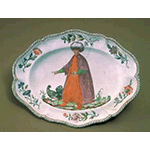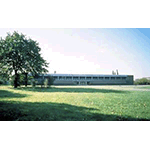Museo Richard-Ginori della Manifattura di Doccia [Richard-Ginori Museum of the Doccia Factory]
The Doccia Factory of porcelain, opened in 1737 by marquis Carlo Ginori at Villa Buondelmonti near Sesto Fiorentino, was one of the first plants in Tuscany that acquired industrial dimensions. In 1741, the grand-ducal court granted it the monopoly for the production of porcelain in Tuscany. Grand Duke Peter Leopold of Lorraine began to place regular orders for the supply of table services for the grand-ducal residences. In the second half of the 19th century, the manufactory participated in the Universal Exhibitions of the Arts and Industry, and in 1861 won the gold medal at the National Exhibition of Florence. In those same years, thanks to continued technical improvements, the factory increased production and acquired growing prestige both in Italy and abroad.
Carlo Ginori reserved several ground-floor rooms of the Villa of Doccia for collecting models, ceramics and kaolins, formed in the course of the factory’s life. In 1896, the Ginori company was purchased by Richard of Milan. Though maintaining property of the historical collections, the Ginori-Lisci family consented to leaving them in store in the rooms where they had been exhibited from the beginning. The Ginori-Lisci collection gradually grew with new objects belonging to Richard-Ginori. During World War II, the collections were packed and placed in safekeeping. In 1950, the entire collection was subjected to conservation constraints, and an agreement was reached with the Ginori-Lisci family who repurchased one-third of its collection, leaving the remaining two-thirds to the Richard-Ginori Ceramics Company. Expressly built and inaugurated in 1965, today’s Museum of Sesto Fiorentino preserves the Ginori legacy, in addition to all the objects collected following the merger with Richard.
The collection includes objects of majolica, porcelain and pottery, made by the Factory from 1737 to today. One section is dedicated to ceramics produced by other manufactories between the late 19th century and the early 20th century. Models in lead, terracotta, gesso, sulphur and wax are also conserved. Of these, the wax models are particularly important, as they are original works from the workshops of the two late-Baroque Florentine sculptors Massimiliano Soldani Benzi and Giambattista Foggini.
The Factory Historical Archive, conserved in the Museum, comprises materials datable between the 19th century and the 1930s: reports, balances, catalogues, certificates of participation in International Exhibitions, letters, in addition to 5000 sketches and drawings. The Library gathers publications from the mid 18th century to today: texts on ceramics history and illustrated volumes utilised to make the decorations on ceramics, including works of botany and zoology of the 18th century.
****************************
Texts by Graziano Magrini
English translation by Victor Beard
Last update 17/mar/2009





